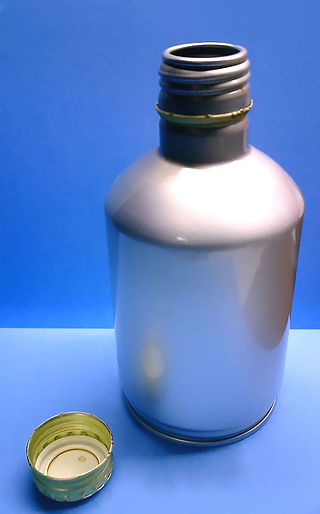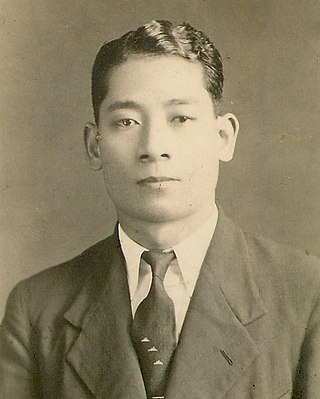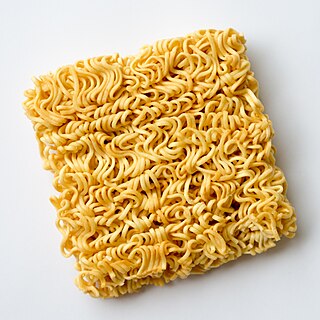
A test tube, also known as a culture tube or sample tube, is a common piece of laboratory glassware consisting of a finger-like length of glass or clear plastic tubing, open at the top and closed at the bottom.

A bottle cap or bottle top is a common closure for the top opening of a bottle. A cap is sometimes colorfully decorated with the logo of the brand of contents. Metal caps with plastic backing are used for glass bottles, sometimes wrapped in decorative foil. Metal caps are usually either steel or aluminum, and of the crown cork type. Flip-top caps preceded such caps.

Chinese noodles vary widely according to the region of production, ingredients, shape or width, and manner of preparation. Noodles were invented in China, and are an essential ingredient and staple in Chinese cuisine. They are an important part of most regional cuisines within China, and other countries with sizable overseas Chinese populations.

A stopper, bung, or cork is a cylindrical or conical closure used to seal a container, such as a bottle, tube, or barrel.

A closure is a device used to close or seal a container such as a bottle, jug, jar, tube, or can. A closure may be a cap, cover, lid, plug, liner, or the like. The part of the container to which the closure is applied is called the finish.
A thistle tube is a piece of laboratory glassware consisting of a shaft of tube, with a reservoir and funnel-like section at the top. Thistle tubes are typically used by chemists to add liquid to an existing system or apparatus. Thistle funnels are used to add small volumes of liquids to an exact position. Thistle funnels are found with or without taps.

A glass bottle is a bottle made from glass. Glass bottles can vary in size considerably, but are most commonly found in sizes ranging between about 200 millilitres and 1.5 litres. Common uses for glass bottles include food condiments, soda, liquor, cosmetics, pickling and preservatives; they are occasionally also notably used for the informal distribution of notes. These types of bottles are utilitarian and serve a purpose in commercial industries.

Momofuku Ando, born Go Pek-Hok, was an inventor and businessman who founded Nissin Food Products Co., Ltd. He is known as the inventor of Nissin Chikin Ramen and the creator of the brands Top Ramen and Cup Noodles.

A vial is a small glass or plastic vessel or bottle, often used to store medication in the form of liquids, powders, or capsules. They can also be used as scientific sample vessels; for instance, in autosampler devices in analytical chromatography. Vial-like glass containers date back to classical antiquity; modern vials are often made of plastics such as polypropylene. There are different types of vials such as a single dose vial and multi-dose vials often used for medications. The single dose vial is only used once whereas a multi-dose vial can be used more than once. The CDC sets specific guidelines on multi-dose vials.

A Fleaker is a brand of container for liquids used in the laboratory. It can be described as a cross between the Griffin beaker and the Erlenmeyer flask.

Shirataki are translucent, gelatinous Japanese noodles made from the corm of the konjac plant. In traditional Japanese cuisine, they are eaten in soups or stir-fried. The texture is chewy, similar to a tough jelly, and has little flavor before seasoning.

Dirty Work is a Pre-Code Laurel and Hardy short film classic comedy made in 1933. It was directed by Lloyd French, produced by Hal Roach and distributed by MGM.

Crossing-the-bridge noodles is a rice noodle soup that originates from the Yunnan province of China. It is one of the best-known dishes in Yunnan cuisine.

Reagent bottles, also known as media bottles or graduated bottles, are containers made of glass, plastic, borosilicate or related substances, and topped by special caps or stoppers. They are intended to contain chemicals in liquid or powder form for laboratories and stored in cabinets or on shelves. Some reagent bottles are tinted amber (actinic), brown or red to protect light-sensitive chemical compounds from visible light, ultraviolet and infrared radiation which may alter them; other bottles are tinted blue or uranium green for decorative purposes -mostly vintage apothecary sets, from centuries in which a doctor or apothecary was a prominent figure. The bottles are called "graduated" when they have marks on the sides indicating the approximate amount of liquid at a given level within the container. A reagent bottle is a type of laboratory glassware. The term "reagent" refers to a substance that is part of a chemical reaction, and "media" is the plural form of "medium" which refers to the liquid or gas which a reaction happens within, or is a processing chemical tool such as a flux.

Instant noodles, or instant ramen, is a type of food consisting of noodles sold in a precooked and dried block with flavoring powder and/or seasoning oil. The dried noodle block was originally created by flash-frying cooked noodles, which is still the main method used in Asian countries; air-dried noodle blocks are favored in Western countries. Dried noodle blocks are designed to be cooked or soaked in boiling water before eating. Ramen, a Japanese adaptation of Chinese noodle soup, is sometimes used as a descriptor for instant noodle flavors by some Japanese manufacturers. It has become synonymous in the United States with all instant noodle products.

Mie koclok, is an Indonesian chicken noodle soup, a specialty of Cirebon city, West Java. The noodles come with a white-colored extra-thick porridge-like soup, made of chicken broth and coconut milk soup, which is coagulated with corn starch or tapioca. Other ingredients include shredded chicken breast, cabbage, bean sprouts, hard boiled egg, kaffir lime juice, and sprinkled with sliced fresh celery, spring onion, and fried shallot.

Mie kocok, is an Indonesian beef noodle soup, a specialty of Bandung City, West Java. The dish consists of noodles served in rich beef consommé soup, kikil, bean sprouts and bakso, kaffir lime juice, and sprinkled with sliced fresh celery, scallion, and fried shallot. Some recipes might add beef tripe.

Recycle Rush was the 2015 FIRST Robotics Competition game. It involves picking up and stacking totes on scoring platforms, putting pool noodles ("litter") inside recycling containers, and putting the containers on top of scoring stacks of totes. There is also a coopertition aspect of the game where both alliances of teams can pool their totes and stack them on a step dividing the field to each gain twenty points. Along with these robot actions, human players can attempt to throw the pool noodles across the field to gain four points for each noodle left in the opposing alliance's work zone.

A laboratory rubber stopper or a rubber bung or a rubber cork is mainly used in chemical laboratories in combination with flasks and test tube and also for fermentation in winery. Generally, in a laboratory, the sizes of rubber stoppers can be varied up to approximately 16 sizes and each of it is specific to certain type of container. As the rubber stopper is used in many experiments, some specific experiment requires a specific material. For example, the M35 Green neoprene stopper is for chemical resistance. For food fermentation, M18 white natural gum is preferred. For high temperature application, red or white silicone rubber stoppers should be used.

Vegetarian bee hoon is a Singaporean noodle dish which comprises vegetarian spring rolls, fried tofu skin, and mock meats made from gluten. Usually, the bee hoon is fried first and put in a large container, when an order is placed, other cooked ingredients are added to the bee hoon. Vegetarian bee hoon and other Chinese vegetarian culinary dishes are said to have originated from vegetarian restaurants established by Chinese Buddhist women.


















